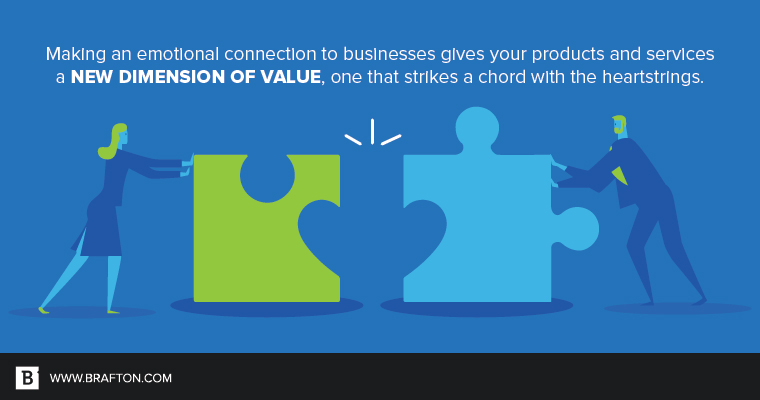When business decision-makers go home at night, they chop onions. They tuck their children into bed. Maybe they catch up on Game of Thrones. They wake up the next morning and brew their favorite brand of coffee. When they scan through Facebook on the train to work, they might come across Old Spice’s famous “The Man Your Man Could Smell Like,” campaign or Always’ heartrending “Like a Girl” video.
Respectively, they laugh and they cry because they are human.
The huge misconception in modern B2B marketing is that when those individuals walk into their offices, they leave that humanity at the door – that when they read your marketing email, they want to hear about value and ROI, not funny men on horses or how “run like a girl” should never stop meaning „run as fast as you can“ as girls grow up.
But of course they want to see those things!
The problem is that no one in the B2B space is showing it to them. And whoever does first has significant potential to turn heads, and profit.
An emotional B2B campaign looks like .. a cat drinking milk?
According to Vice President of Content at Brafton, Francis Ma, emotional B2B marketing is all about getting someone to associate a piece of content with an emotion.
If you do this with one video, case study or testimonial, that piece of content becomes the emotional ambassador for your brand. It acts as the pathos to your white papers‘ logos and your blog posts‘ ethos.
Take the example of Cisco’s Internet of Everything concept. For years the tech giant has used research to position itself as a leader in connecting a network of smart objects, what many of us know as the Internet of Things.
But it also contextualized this thought leadership to businesses in a human way: A three-minute video that connects a cat drinking milk to its owner securing data in an office, so that data can be transmitted via satellite to a sprinkler system, which waters the grass, that a cow eats, to make milk that the man’s smart refrigerator tells him to buy on his way home, so that his daughter back at the house can pour the milk into a bowl so that the cat can drink it.
The genius of this video is how it homes in on the strategic sweet spot that far too many businesses glide right over:
The part of the consumer’s story where a particular lead’s service or solution plays an important role.
Cisco’s ad shows the data security and transmission company’s story, the agricultural industry’s story and, finally, the smart device manufacturer’s story. All of these are hypothetical business markets that Cisco may want to target for lead generation.
And what more human way to bring them all together than the story of a little girl giving her cat a bowl of milk?
Is its message relevant to businesses? Yes.
Is it relatable enough to be human? Absolutely.
Those attributes make this emotional B2B marketing instead of just another cat video on YouTube.

Building up to an emotional payoff
Making an emotional connection to businesses gives your products and services a new dimension of value, one that strikes a chord with the heartstrings. It’s also true that video tends to be the favored medium for delivering that emotional payoff.
But that payoff needs to be worked up to with a full picture of what your offerings can do, otherwise, your own role in that story may not come across clearly enough to the target audience.
In other words, your emotionally charged video content can’t shine in an empty auditorium.
You need to promote the show so you can fill the house, and get the attention that your brand needs. That requires strong landing pages, top-of-funnel content such as blog posts and eBooks and some deeper level collateral such as a white paper or testimonial to act as companions – or leaflets – to the main event.
Loyalty for authenticity – a fair trade
Like any super power, the ability to create an emotional response that can win over a business audience comes with its risks – namely, creating the wrong response.
Case in point: Pepsi’s “Join the Conversation” ad featuring Kendall Jenner.
The trick to not ending up in that position is to know your audience. Know what makes them tick – and for that matter, dry heave. Getting that part right is crucial to being authentic.
Then, create context in which your brand’s presence – or implied presence – leads to a legitimate emotional outcome. Your target audience needs to understand that your brand is responsible for creating the authentic warm and fuzzy feeling they get when they think of a piece of content.
The power of authentic human emotion is that it can resonate with anyone – regardless of which side of the office door they’re on.
Because at the end of the day, we’re people first. Living, breathing, feeling decision-makers who value our humanity just as much, if not more, than the immediate promise of efficient workflows and ROI.





